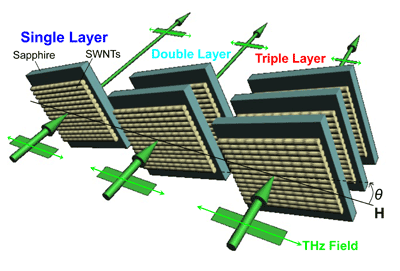Source: Electronic Products.
A team of researchers at Rice University is using carbon nanotubes as the critical component of a robust terahertz polarizer. The team hopes that this development will accelerate the design of new communication, security, sensing, and noninvasive medical imaging devices.

A triple layer of carbon nanotube arrays on a sapphire base are the basis for a new type of terahertz polarizer. (Courtesy: Lei Ren/Rice University.)
Depending on its polarization, the polarizer selectively allows 100% of a terahertz wave to pass or blocks 99.9% of it. Developed by Rice University professor Junichiro Kono, the device is claimed the most effective ever reported. In addition, the broadband polarizer handles waves from 0.5 to 2.2 THz, surpassing the range of traditional polarizers that consist of fragile grids wrapped in gold or tungsten. Terahertz waves exist at the transition between infrared and microwaves. They are not harmful, and they penetrate fabric and plastic, but not metal or water.
The teamwork by Kono and Lei Ren makes use of the basic research into carbon nanotubes for which Rice University is famous. Researchers Robert Hauge and Cary Pint developed a way to grow nanotube carpets and transfer well-alligned arrays of nanotubes from a catalyst to any substrate they chose, limited only by the size of the growth platform.
Four years ago the team came across the material, indium antimonide, that blocks or passes terahetz waves. This would only happen at low temperatures in a strong magnetic field. During that time Kono’s team was working with carbon nanotube arrays transferred onto a sapphire substrate developed by Pint and Hauge. Those aligned arrays turned out to be very effective at filtering terahertz waves.
“When the polarization of the terahertz wave was perpendicular to the nanotubes, there was absolutely no attenuation,” Kono recalled. “But when the polarization was parallel to the nanotubes, the thickness was not enough to completely kill the transmission, which was still at 30% to 50%.” So they made the polarizer thicker ― three decks of aligned carbon nanotubes on sapphire substrates (as shown in the image), enough to effectively absorb all of the incident terahertz radiation.
Details on the research was published in the online version of the American Chemical Society journal Nano Letters.

